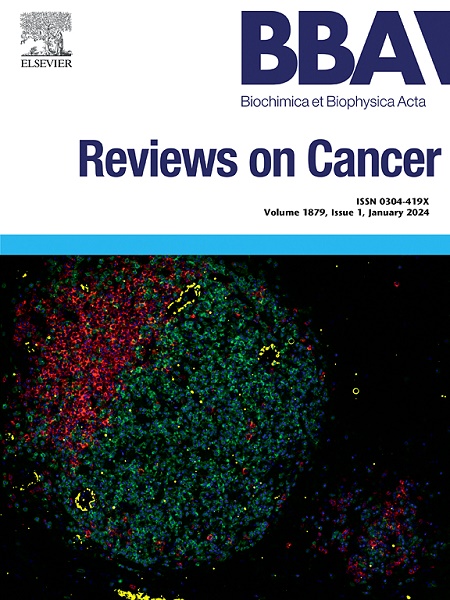Histological transformation in lung cancer: Mechanisms, clinical characteristics, and therapeutic approaches
IF 9.7
1区 医学
Q1 BIOCHEMISTRY & MOLECULAR BIOLOGY
Biochimica et biophysica acta. Reviews on cancer
Pub Date : 2025-08-08
DOI:10.1016/j.bbcan.2025.189413
引用次数: 0
Abstract
Lung cancer, the leading cause of cancer-related mortality globally, exhibits remarkable histological plasticity, with non-small cell lung cancer (NSCLC) frequently transforming into small cell lung cancer (SCLC) as a resistance mechanism to targeted therapies and immunotherapies. The molecular mechanisms and treatments for SCLC transformation remain unclear. This review analyzes the mechanisms, molecular features, and treatment landscape of histological transformation, particularly in EGFR-mutant NSCLC. Key findings include: (1) RB1 and TP53 co-inactivation is a hallmark of transformed SCLC, enabling lineage plasticity via epigenetic and neuroendocrine changes; (2) the tumor immune microenvironment becomes immunosuppressive during transformation; and (3) new therapies targeting DLL3 and AURKA show promise in early trials. This study offers a comprehensive framework to understand histological transformation in lung cancer. It underscores the importance of routine re-biopsies for early detection and supports the development of biomarker-guided therapies. Future research should validate predictive biomarkers and optimizing combination therapies for transformed SCLC.
肺癌的组织学转变:机制、临床特征和治疗方法。
肺癌是全球癌症相关死亡的主要原因,具有显著的组织学可塑性,非小细胞肺癌(NSCLC)经常转化为小细胞肺癌(SCLC),这是对靶向治疗和免疫治疗的耐药机制。SCLC转化的分子机制和治疗方法尚不清楚。本文分析了组织学转化的机制、分子特征和治疗前景,特别是在egfr突变的NSCLC中。主要发现包括:(1)RB1和TP53共失活是SCLC转化的标志,通过表观遗传和神经内分泌改变实现谱系可塑性;(2)肿瘤免疫微环境在转化过程中具有免疫抑制性;(3)针对DLL3和AURKA的新疗法在早期试验中显示出希望。本研究为了解肺癌的组织学转变提供了一个全面的框架。它强调了常规再活检对早期发现的重要性,并支持生物标志物引导疗法的发展。未来的研究应该验证可预测的生物标志物,并优化转化SCLC的联合治疗。
本文章由计算机程序翻译,如有差异,请以英文原文为准。
求助全文
约1分钟内获得全文
求助全文
来源期刊

Biochimica et biophysica acta. Reviews on cancer
医学-生化与分子生物学
CiteScore
17.20
自引率
0.00%
发文量
138
审稿时长
33 days
期刊介绍:
Biochimica et Biophysica Acta (BBA) - Reviews on Cancer encompasses the entirety of cancer biology and biochemistry, emphasizing oncogenes and tumor suppressor genes, growth-related cell cycle control signaling, carcinogenesis mechanisms, cell transformation, immunologic control mechanisms, genetics of human (mammalian) cancer, control of cell proliferation, genetic and molecular control of organismic development, rational anti-tumor drug design. It publishes mini-reviews and full reviews.
 求助内容:
求助内容: 应助结果提醒方式:
应助结果提醒方式:


